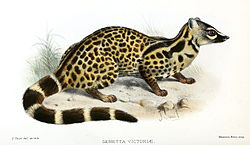| Giant forest genet | |
|---|---|
 | |
| Scientific classification | |
| Kingdom: | Animalia |
| Phylum: | Chordata |
| Class: | Mammalia |
| Order: | Carnivora |
| Family: | Viverridae |
| Genus: | Genetta |
| Species: | G. victoriae |
| Binomial name | |
| Genetta victoriae Thomas, 1901 | |
 | |
| Giant forest genet range | |
The giant forest genet (Genetta victoriae), also known as the giant genet, is a genet species endemic to the Congo Basin. As it is considered as widely distributed and common, it is listed as Least Concern on the IUCN Red List. [1]
